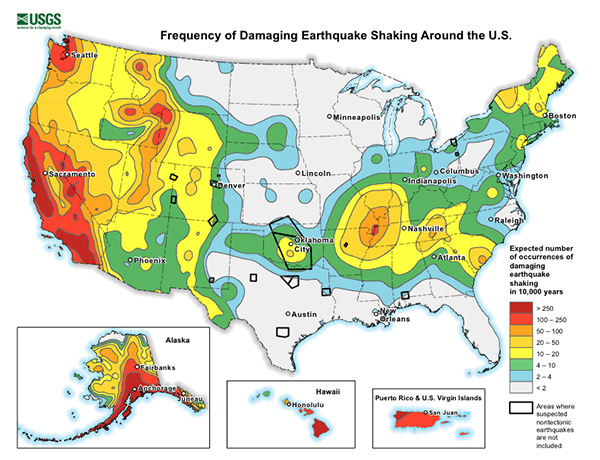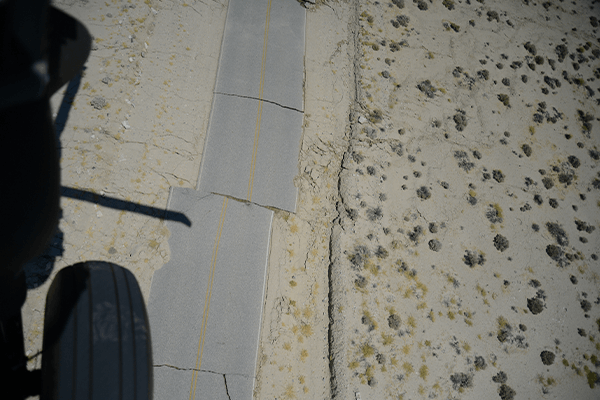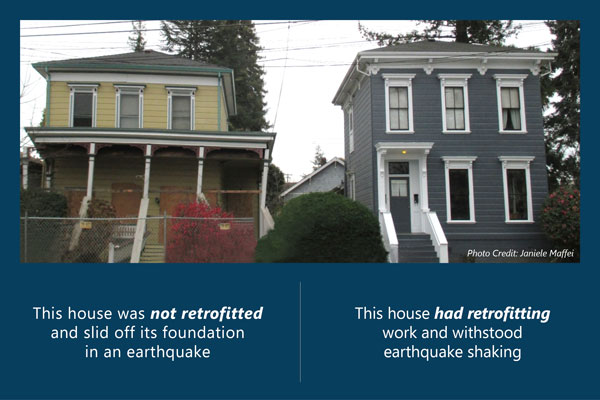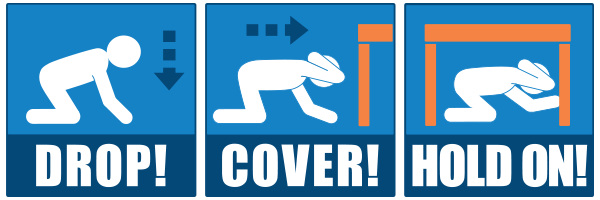Exploring the Chances of Earthquakes in California
Did you know? According to the California Department of Conservation's California Geological Survey:
- There are 15,000 known faults in California.
- More than 500 of those faults are categorized as active.
- Most Californians live within 30 miles of an active fault.
No one in the Golden State is risk-free when it comes to earthquakes. Scientists agree that there is more than a 99 percent chance of one or more major earthquakes striking California in the next 30 years.*
The odds are good that if you live in California, you will experience an earthquake at some time. While the probability of an earthquake in California is higher than most states, they do vary from region to region.
Learn how to get free grant funding to strengthen your home
Is your house type vulnerable to earthquakes? You could receive funding to pay for a seismic retrofit! Sign up to receive notifications about program registration, when the programs expand to new ZIP codes, and more.
You may unsubscribe at any time. We value your privacy and never share or sell your email address.
What is the earthquake likelihood at location X?
Many people ask, “what is the earthquake likelihood in my community?” The United States Geological Survey (USGS) has an online tool for determining the probability of a large earthquake within 31 miles of a specific location in the United States over a certain period of time.
The tool can be found on the USGS site. The information sums up the earthquake probabilities in the different regions of California. The earthquake probability calculator is based on the latest available information from seismic hazard data.
Also, check out their National Hazard Maps. The national seismic hazard map shows how often scientists expect damaging earthquakes across the country.
Southern California earthquake probabilities
When many people living in Southern California and, specifically, the Greater Los Angeles Area (Los Angeles County, Orange County, Riverside County, San Bernardino County, and Ventura County), think about earthquake risk and earthquake probabilities, they think of the region’s proximity to the Southern San Andreas fault. The San Andreas fault is California’s longest fault and the one that gets the most attention. It slices through Los Angeles County along the north side of the San Gabriel Mountains. It can cause powerful earthquakes—as big as magnitude 8.
Magnitude 6.7 or higher
In their most recent report, the USGS’s earthquake forecast predicted a 93% chance of a larger earthquake—aka one or more magnitude 6.7 or greater earthquakes—striking Southern California.
While the San Andreas is Southern California’s most well-known fault, earthquakes in the region also happen on other, smaller faults. In 1994, the magnitude 6.7 earthquake struck near Northridge, killing 58 people, injuring more than 9,000 and causing more than $49 billion in economic loss. This was caused primarily by the Northridge Blind Thrust fault, which triggered activity in several other faults.
More recently, the 2019 Ridgecrest earthquakes were California’s biggest in more than 20 years, and a USGS report suggested they involved as many as five fault zones, including the Owens Valley fault zone, Panamint Valley fault zone, Garlock fault zone, Blackwater fault zone, and San Andreas fault zone. On the morning of Thursday, July 4th, a magnitude 6.4 earthquake struck in the Mojave Desert near Searles Valley. Multiple aftershocks followed, and on the evening of July 5th, another earthquake struck in the same area with a magnitude of 7.1.
Many SoCal residents feel shaking from earthquakes a couple of times a year, most mild or moderate with little damage and no injuries. But, on average, a quake of magnitude 6 or larger is likely to hit somewhere in Southern California every few years.
Central Valley earthquake probabilities
Like all of California, the Central Valley, which is ringed by faults, is earthquake country. Earthquake shaking can begin suddenly, but have lasting impacts.
The San Andreas fault system is to the west, the Garlock fault is to the south and the faults of the Sierra Nevada are to the east. The San Andreas fault system could create the biggest earthquakes in the region—as big as magnitude 8—that would disrupt a wide-ranging area of the Central Valley. But smaller magnitude earthquakes could also cause damaging levels of ground shaking.
Magnitude 6.7 or higher
In their most recent report, the USGS predicted more than a 99 percent chance of one or more magnitude 6.7 or greater earthquakes striking somewhere in California.
Further, a study by the USGS indicates that a portion of the San Andreas fault near Tejon Pass could be overdue for a major earthquake. As the study notes, when it comes to earthquake probabilities along this section of the San Andreas fault, earthquakes occur about every 100 years with the last major earthquake occurring in this area in 1857. That earthquake was called the Fort Tejon quake and was a magnitude 7.9.
Northern California earthquake probabilities
In the highly populated areas of Northern California and the Bay Area, scientists estimate there is a nearly 3 out of 4 chance of one or more magnitude 6.7 or greater earthquakes striking the San Francisco region in the near future—and a 95% chance in Northern California overall—with the earthquake risk spread throughout and across the sprawling region.
The three Bay Area faults most likely to cause a damaging earthquake are the Hayward fault, the Calaveras fault and the San Andreas fault. The East Bay has a higher earthquake risk than the San Francisco Peninsula. In San Jose, several major faults intersect the city and nearby communities—and it’s the largest city on the north San Andreas fault line. In 2019, the USGS released a new earthquake probability map that raised the risk of earthquake damage in San Jose and the South Bay communities.
Magnitude 6.7 or higher
Scientists say there is a 95 percent chance of one or more magnitude 6.7 or greater earthquakes striking Northern California.
Also in Northern California is the famed wine country (which includes Napa County and Solano County), which is not immune to strong earthquakes. In 2014 a magnitude 6.0 earthquake along the West Napa Fault killed one person, injured at least 208 people and caused severe damage to 150 buildings and moderate damage to more than 1,000 structures. The photo below shows the damage caused by the earthquake and vividly demonstrates the importance of retrofitting older homes to better withstand the shaking caused by major earthquakes.
When it comes to earthquake probabilities in the Greater Bay Area, USGS names the prime sources as the San Andreas fault, the Calaveras fault and the Hayward fault. Seven million Bay Area residents need to be prepared for a major earthquake and weeks of aftershocks. Damages from a Hayward fault rupture alone could shake one million homes, with 77,000 to 152,000 households displaced.
what is your earthquake risk if you live in California?
While generally speaking, scientists say there is more than a 99 percent chance of at least one magnitude 6.7 or greater earthquakes occurring over a 30-year period in the Golden State, the specific risk you face from a major earthquake is based on what part of the state you live in. You can find out about major faults in your area by checking out the USGS's interactive fault map.
How to keep your family safe in an earthquake
There are ways you can protect your home and your family in the event of a major earthquake.
They include:
- Consider retrofitting your older house to reduce the risk of it sliding off its foundation or collapsing (see retrofitting information below).
- Bolt and brace water heaters and gas appliances to wall studs. Have a professional install flexible fittings to avoid gas or water leaks.
- Do not hang heavy items, such as pictures and mirrors, near beds, couches and anywhere people sleep or sit.
- Install strong latches or bolts on cabinets. Large or heavy items should be closest to the floor.
- Learn how to shut off the gas valves in your home and keep a wrench handy for that purpose.
- Place large and heavy objects and breakable items on lower shelves. Use museum putty to hold items in place.
- Anchor overhead fixtures to joists.
- Anchor top-heavy, tall and freestanding furniture, such as bookcases and china cabinets, to wall studs to keep these from toppling over.
- Ask about home repair and strengthening tips for exterior home features, such as chimneys, porches, decks, sliding glass doors, canopies, carports and garage doors.
- Go to the Red Cross Earthquake Safety page for more useful information and tips.
Learn the seven steps to earthquake safety
No one can predict when or where potential earthquakes will strike, but you and your family can be prepared before the next big one hits. The following earthquake preparation tips take only a few hours and will help you create a plan and organize supplies that will keep you safer. You can visit our Seven Essential Earthquake Safety Steps page for more information.
Step 1: Secure your space by identifying earthquake hazards.
Step 2: Plan to be safe by creating a disaster plan and deciding how you will communicate in an emergency.
Step 3: Organize disaster supplies in convenient locations.
Step 4: Minimize financial hardship by organizing important documents, strengthening your property and considering insurance.
Step 5: Drop, cover, and hold on when the earth shakes.
Step 6: Improve safety after earthquakes by evacuating if necessary, helping the injured and preventing further damage.
Step 7: Reconnect and restore daily life by communicating with others, repairing damage and rebuilding.
How to protect your home
Even though it is impossible to accurately predict when an earthquake will occur, you can still take measures to reduce damage and improve the chances of staying safe by preparing in advance for earthquakes. The ways in which you can protect your home and your family in the event of a major earthquake include:
- Create an earthquake safety plan for you and loved ones, including pets.
- Know your risk for earthquakes in your area and what you must do to stay safe.
- Make or purchase earthquake safety kits.
- Find out if your home needs seismic retrofitting.
- Identify and fix potential earthquake hazards in your home.
- Secure fixtures, furniture, appliances and other items inside your home.
- Visit our Resources page for more safety, protection and emergency preparedness tips.
Determine your structural risks
If you live in California and your older house was built before 1980, earthquake experts say your dwelling may be especially vulnerable to damage from earthquake shaking because it was built before modern seismic building codes were put in place. The frames of hundreds of thousands of these types of homes are not bolted to their foundations. And without adequate bracing and bolting, these houses can slide or topple off their foundation during an earthquake.
Other types of houses, such as those with living space over garage, those with post & pier footings, and those built on hillsides can also have inherent vulnerabilities that make them more at risk for earthquake damage.
You can learn more at our Strengthen Your House page.
Consider a seismic retrofit
Strengthening your house with a seismic retrofit is a good way to help prevent costly earthquake damage. It can help provide peace of mind, knowing that you have helped your family better withstand an earthquake by strengthening where you live.
The retrofitting process itself can be straightforward and often not as intrusive as homeowners might think. Depending on the type of retrofit needed, the work usually can be done in a few days and homeowners can remain inside, as in almost all instances workers do the retrofitting without entering the residence. If your house is older and sits on a raised foundation, odds are it may need to be seismically retrofitted to have a better chance to withstand earthquake damage.
For more information on the importance of retrofitting older homes, and to see if your home type might be at risk, visit our Strengthen Your House page.
Strengthen your home!
For many California homeowners, the value of their property and the equity they have in it represent the lion’s share of their savings and retirement nest egg. A seismic retrofit can significantly reduce the chances of an older home falling or sliding completely off its foundation—perhaps resulting in a total loss, even in a moderate earthquake.
Based on earthquake probabilities, it is not a matter of if, but when the next big one will strongly rattle a region of California. So why not be better prepared to protect your family, your home and your future by taking the path of most resilience and strengthening your house against earthquake damage today!
*The earthquake likelihoods described in this blog are based on a 30-year period, beginning in 2014, from the Third Uniform California Earthquake Rupture Forecast (UCERF3).




